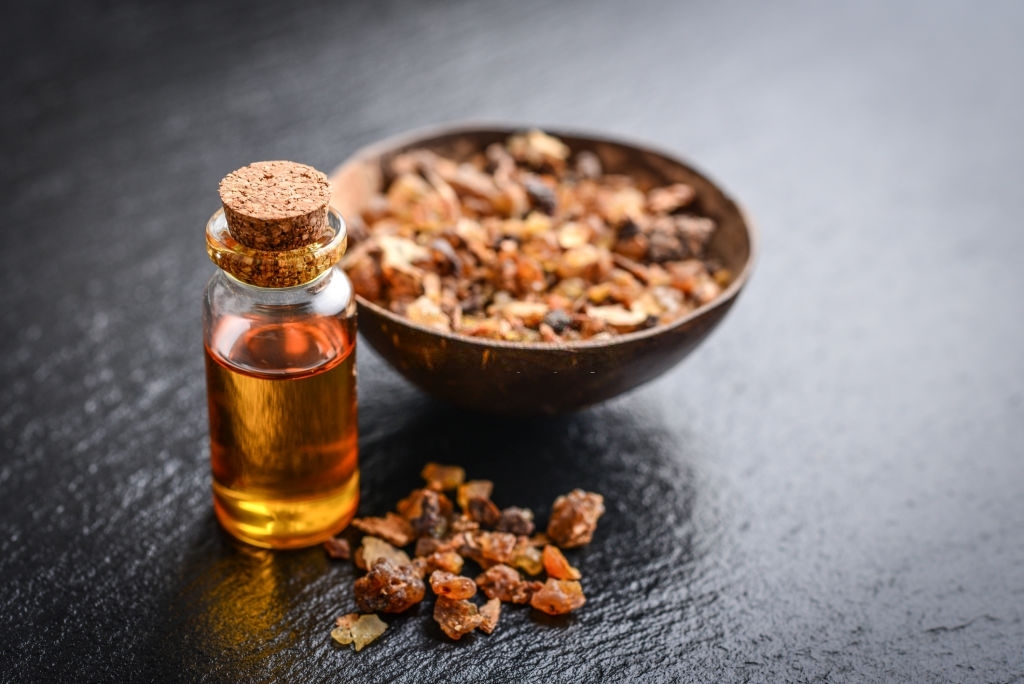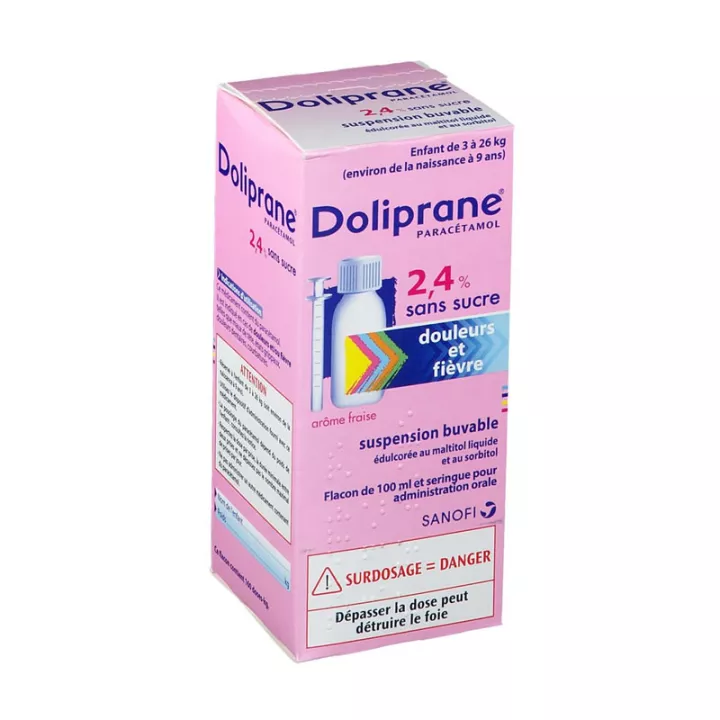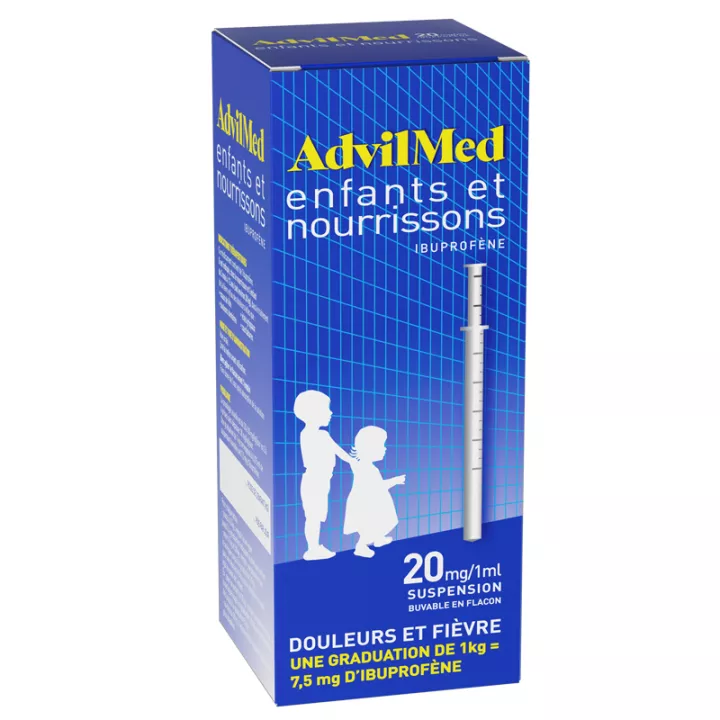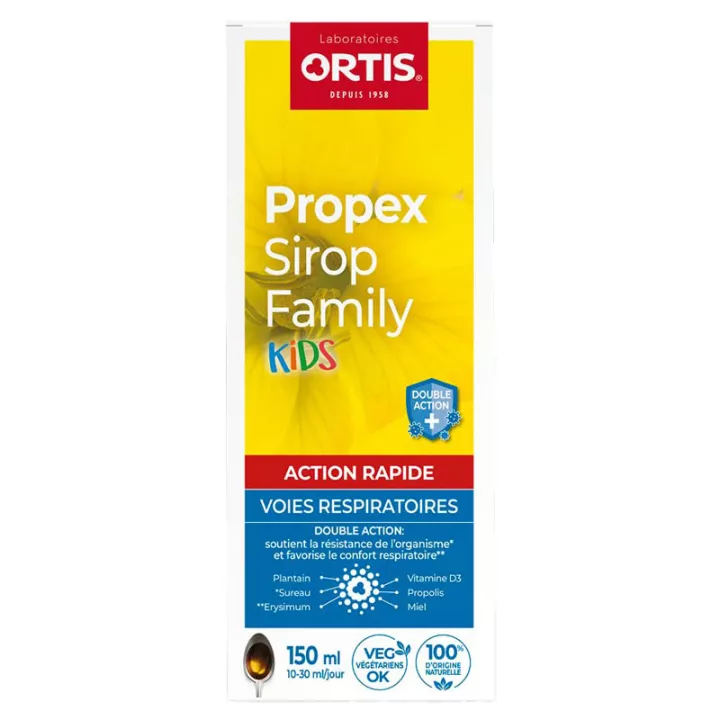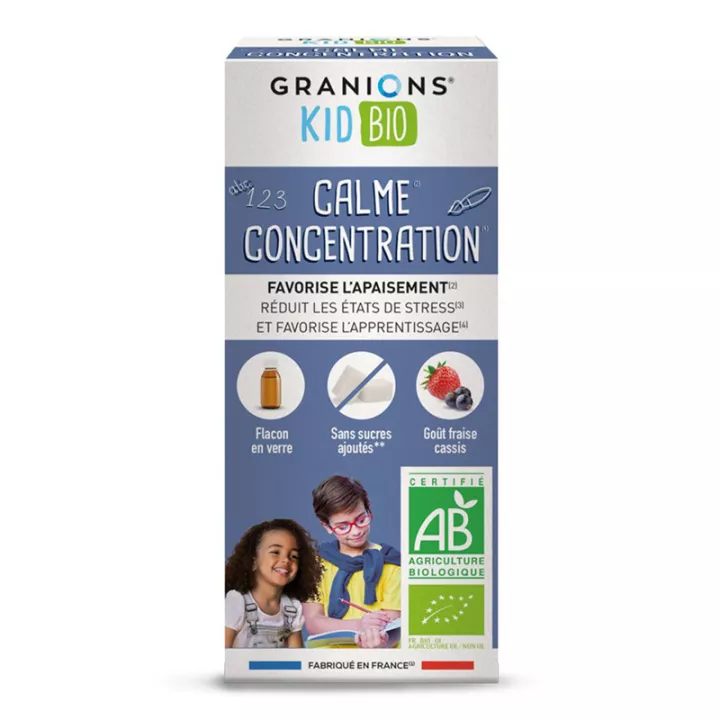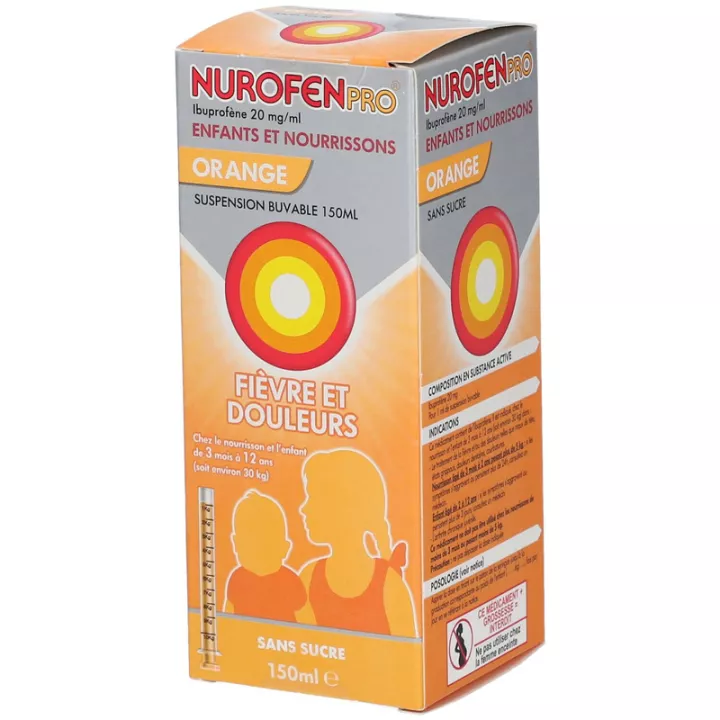NOTICE
ANSM - Updated on: 26/07/2017
Description of the Medicine
DOLIPRANE 2.4 PERCENT WITHOUT SUGAR, oral suspension sweetened with liquid maltitol and sorbitol
© PARACA Tamol
© framed
Please read this leaflet carefully before you start taking this medication because it contains important information for you.
You should always take this medication exactly as prescribed by your doctor or pharmacist.
AT· Keep this leaflet. You might need to read it again.
AT· Contact your pharmacist for advice or information.
AT· If you experience any side effects, talk to your doctor or pharmacist. This also applies to any undesirable effects not mentioned in this leaflet. See section 4.
AT· You should contact your doctor if you experience no improvement or feel less well after 3 days in case of fever or 5 days in case of pain.
Do not allow this medication to reach children.
What is in this leaflet?
1. What is DOLIPRANE 2.4 PERCENT WITHOUT SUGAR, oral suspension sweetened with liquid maltitol and sorbitol and in which cases is it used?
2. What should be known before taking DOLIPRANE 2.4 PERCENT WITHOUT SUGAR, oral suspension with liquid maltitol and sorbitol?
3. How to take DOLIPRANE 2.4 PERCENT WITHOUT SUGAR, oral suspension with liquid maltitol and sorbitol?
4. What are the possible undesirable effects?
5. How to store DOLIPRANE 2.4 PERCENT WITHOUT SUGAR, oral suspension with liquid maltitol and sorbitol?
6. Contents of the package and other information.
1. WHAT IS DOLIPRANE 2.4 PERCENT WITHOUT SUGAR, oral suspension sweetened with liquid maltitol and sorbitol AND IN WHAT CASES IS IT USED?
Pharmacotherapeutic group: OTHER ANALGESICS AND ANTIPYRETICS - ATC code: N02BE01
DOLIPRANE 2.4 PERCENT WITHOUT SUGAR is an analgesic (calms the pain) and an antipyretic (lowers the fever).
The active substance of this medication is paracetamol.
It is used to treat pain and / or fever, for example in the case of headaches, flu, dental pain, aches.
This presentation is reserved for the child from 3 to 26 kg (approximately from birth to 9 years). Read carefully "Dosage".
For children of different weights, there are other paracetamol specimens with a more appropriate dosage. Do not hesitate to ask your doctor or pharmacist for advice.
2. BEFORE YOU TAKE DOLIPRANE 2.4 PERCENT WITHOUT SUGAR, drinkable suspension sweetened with liquid maltitol and sorbitol?
Never give DOLIPRANE 2.4 PERCENT WITHOUT SUGAR:
AT· If your child is allergic (hypersensitive) to the active substance (paracetamol) or to any of the other ingredients in DOLIPRANE 2.4 PERCENT WITHOUT SUGAR. You will find the list of components in section 6.
AT· If your child has a serious liver disease.
This medicine contains paracetamol. Other medicines contain it. Check that you are not taking any other medicines containing paracetamol, including if they are medicines obtained without a prescription. Do not combine them , so as not to exceed the recommended daily dose. (see "Dosage" and "Symptoms and Instructions for Overdose") |
Warnings and Precautions
Talk to your doctor or pharmacist before using DOLIPRANE 2.4 PERCENT WITHOUT SUGAR .
Take special care with DOLIPRANE 2.4 PERCENT WITHOUT SUGAR:
AT· If the pain persists more than 5 days, or the fever is longer than 3 days, or if there is insufficient efficacy or any other signs, do not continue treatment without your doctor's advice.
AT· Taking paracetamol may lead to liver function problems.
AT· You should ask your physician for advice before giving this medicine to your child:
o if he has a liver disease or a serious kidney disease,
o if he suffers from dehydration,
o if he suffers from chronic malnutrition, for example, if he is in the eel period, if he has lost a lot of weight recently, if he is infected with the AIDS virus or a hepatitis if he is suffering from cystic fibrosis (genetic and hereditary disease characterized by severe respiratory infections), or if he is suffering from Gilbert's disease associated with an increase in bilirubin levels in the blood).
o if he is allergic to aspirin and / or non-steroidal anti-inflammatory drugs
AT· For information purposes: the consumption of alcoholic beverages during treatment is discouraged.
AT· In cases of recent withdrawal from chronic alcoholism, the risk of hepatic disease is increased.
AT· If administered to a child, the dose depends on its weight (see section "How to take DOLIPRANE 2.4 PER CENT").
AT· In case of acute viral hepatitis, stop treatment and consult your doctor.
Blood tests
Tell your doctor if you are giving DOLIPRANE 2.4 PERCENT WITHOUT SUGAR to your child and that he / she must take a blood test because this medication can distort the results of uric acid mie) and sugar (glycemia) in the blood.
IN CASE OF DOUBT DO NOT HESITATE TO ASK THE NOTICE OF YOUR DOCTOR OR YOUR PHARMACIST.
children
Not applicable.
Other medicines and DOLIPRANE 2.4 PERCENT WITHOUT SUGAR, oral suspension sweetened with liquid maltitol and sorbitol
Tell your doctor or pharmacist if your child is taking or has recently taken or could take any other medicines, including non-prescription medicines.
Do not take any other medicines containing paracetamol. You may be overdosed.
Do not combine this medication with sulfosodium catioresin (active substance used in case of hyperkalemia, an excess of potassium in the blood): the association may lead to a risk of colic necrosis which can be fatal.
If your child is taking oral anticoagulant therapy (warfarin or AVK), taking DOLIPRANE 2.4 PERCENT WITHOUT SUGAR at maximum doses for more than 4 days requires enhanced monitoring of biological examinations including lÂ'INR. In this case, consult your doctor.
The effectiveness of paracetamol may be impaired if you are taking cholesterol-lowering medicines at the same time as decreasing blood cholesterol levels (adhere to an interval of more than 2 hours between the 2 catches).
If your child receives at the same time as paracetamol, a treatment with flucloxacillin (an antibiotic), he / she risks to present a metabolic acidosis (blood too acid to the origin of an acceleration ration of the respiratory frequency).
The toxicity of paracetamol can be increased, if your child takes :
AT· Medicines that are potentially toxic to the liver
AT· Medicines that promote the production of paracetamol toxic metabolite such as anti-epileptic medicines (phenobarbital, phenytoin, carbamazepine, topiramate),
AT· Rifampicin (an antibiotic),
AT· At the same time as alcohol.
DOLIPRANE 2.4 PERCENT WITHOUT SUGAR, drinkable suspension with liquid maltitol and sorbitol with food, drink and alcohol
The consumption of alcoholic beverages during treatment is discouraged.
Pregnancy, breastfeeding and fertility
If you are pregnant or nursing, planning to become pregnant or planning a pregnancy, ask your doctor for advice or pharmacist before taking this medication.
Pregnancy and breast feeding
This medication can be used during pregnancy and breast-feeding. Use the minimum dose to reduce your pain and / or fever for as short a time as possible and as often as possible. Contact your doctor or midwife if pain and / or fever does not decrease or if you need to take this medication more frequently during your pregnancy.
© FertilitÃ
It is possible that paracetamol may alter women's fertility, in a manner that is reversible at the end of treatment.
Sport
Not applicable.
Driving and using machines
Not applicable.
DOLIPRANE 2.4 PERCENT WITHOUT SUGAR, oral suspension sweetened with liquid maltitol and sorbitol contains sorbitol, liquid maltitol, azorubine (E122), ethyl hydroxybenzoate, Ethyl and propyl (NIPASEPT).
AT· This medicine contains sugars (sorbitol and liquid maltitol). Its use is discouraged in patients with fructose intolerance (rare hereditary disease).
AT· If your doctor has already told you that your child has an intolerance to certain sugars, contact him or her before giving this medication.
AT· This medicinal product contains an azo dyestuff (E122 azorubine), ethyl, propyl and propyl (NIPASEPT) hydroxybenzoate and may cause allergic reactions.
3. HOW TO TAKE DOLIPRANE 2.4 PERCENT WITHOUT SUGAR, oral suspension sweetened with liquid maltitol and sorbitol?
Always take this medication exactly as prescribed by your doctor or pharmacist. Check with your doctor or pharmacist if you are unsure.
This presentation is reserved for the child from 3 to 26 kg (approximately from birth to 9 years).
For children of different weights, there are other paracetamol specimens with a more appropriate dosage. Do not hesitate to ask your doctor or pharmacist for advice.
Dosage
The dosage of paracetamol depends on the weight of the child. The ages are mentioned for information purposes.
If you do not know the weight of the child, weigh it in order to give it the most suitable dose.
Paracetamol is available in many dosages, making it possible to adapt the treatment to the weight of each child.
The recommended daily dose of paracetamol is approximately 60 mg / kg / day.
This presentation is suitable for 4-dose administration, ie approximately 15 mg / kg every 6 hours or 10 mg / kg every 4 hours.
The syringe for oral administration, graduated by half-kilogram, allows administering 15 mg / kg / dose. The dose to be administered for a grip is therefore obtained by pulling the piston up to the scale corresponding to the weight of the child. This dose can be renewed if needed after 6 hours, without exceeding 4 times a day.
Examples:
AT· For a child weighing 3.5 kg , the dose per intake is from a syringe for oral administration filled up to the 3.5 kg graduation.
AT· For a child weighing 13 kg , the dose per dose is from a syringe for oral administration filled up to the 13 kg graduation.
AT· For a child weighing 15 kg, the dose per dose is one syringe for oral administration filled up to the 10 kg graduation and one syringe for oral administration filled up to the 5 kg graduation.
For information, a gradation kg corresponds to 0,625 ml of suspension.
The maximum graduation of "13 kg" corresponds to 8.13 ml of suspension, ie approximately 195 mg of paracetamol.
In case of severe kidney disease (severe kidney failure), catches should be spaced at least 8 hours apart.
IN CASE OF DOUBT, ASK FOR ADVICE TO YOUR DOCTOR OR YOUR PHARMACIST.
If you have the impression that the effect of DOLIPRANE 2.4 PERCENT WITHOUT SUGAR is too strong or too weak, consult your doctor or pharmacist.
Mode and route of administration
This medication is used orally.
The suspension can be pure or diluted in a small amount of drink (eg water, milk, fruit juice).
To open the bottle, turn the child safety cap by pressing. The bottle should be closed after each use.
The use of the syringe for oral administration is strictly reserved for the administration of this pediatric suspension of paracetamol.
The syringe for oral administration should be rinsed after each use. Do not let it soak in this bottle.
In addition, if your child has a fever greater than 38.5Â ° C, you can improve the effectiveness of the medication by :
AT· Discover your child,
AT· Make the drink,
AT· Do not leave your child in a hot place.
IN CASE OF DOUBT, ASK FOR ADVICE TO YOUR DOCTOR OR YOUR PHARMACIST.
Frequency of administration
AT· Systematic jacks prevent the oscillations of pain or fever.
AT· The holds should be kept at regular intervals, including at night, preferably 6 hours and a minimum of 4 hours (refer to "Dosage").
AT· If your child has a serious kidney disease (severe kidney failure), you should wait at least 8 hours between each sachet (s).
Duration of treatment
Unless medical notice is given, the duration of the treatment is limited:
AT· At 5 days in case of pain,
AT· 3 days in case of fever.
Stop treatment and check with your doctor immediately:
AT· if the pain persists more than 5 days or the fever lasts more than 3 days,
AT· if pain or fever worsens,
AT· or if new symptoms appear.
If you have given your child more DOLIPRANE 2.4 PERCENT WITHOUT SUGAR, drinkable suspension in sachet sweetened with liquid maltitol and sorbitol that you should not have:
Immediately consult your doctor or pharmacist or medical emergencies.
Overdose can lead to liver disease (hepatic insufficiency), gastrointestinal bleeding, brain disease (encephalopathy), coma, or even especially in populations at higher risk, such as young children, the elderly and in certain situations (liver disease, alcoholism, chronic malnutrition). In the first 24 hours, the main symptoms of poisoning are: nausea, vomiting, loss of appetite, abdominal pain, fetus.
Overdosage may also result in: pancreas (pancreatitis), hyperamylaseemia (increased amylase in the blood), kidney disease (acute renal failure), and a blood problem in which red blood cells, white blood cells and platelets are all reduced in number which results in:
AT· fatigue, shortness of breath, and a finger;
AT· frequent infections accompanied by severe fever and chills, sore throat or ulcers of the mouth;
AT· a tendency to bleed or present spontaneous bruising, nosebleeds.
If you forget to take or give your child DOLIPRANE 2.4 PERCENT WITHOUT SUGAR, drinkable suspension in sachet sweetened with liquid maltitol and sorbitol:
Do not give a double dose to make up for the dose you have forgotten to give.
If you stop using DOLIPRANE 2.4 PERCENT WITHOUT SUGAR, drinkable suspension in sachet sweetened with liquid maltitol and sorbitol:
Not applicable.
4. WHAT ARE POSSIBLE SIDE EFFECTS?
Like all medicines, this medication can cause side effects, although not everybody gets them.
AT· Rarely, an allergic reaction may occur:
o Pimples and / or redness on the skin,
o Urticaria,
o Sudden swelling of the face and neck may cause difficulty in breathing (Angioedema),
o Abrupt malaise with a significant drop in arterial pressure (anaphylactic shock).
If an allergy occurs, you should stop giving your child this medication and consult your doctor promptly. In the future, you should never give your child any medicine containing paracetamol.
AT· Very rare cases of severe adverse skin reactions have been reported
AT· Exceptionally, this drug may decrease the number of certain blood cells: white blood cells (leukopenia, neutropenia), platelets (thrombocytopenia), which may manifest as nosebleeds or gums. In this case, consult a physician.
AT· Other possible undesirable effects (the frequency of which can not be estimated from the available data): liver function disorders, severe reduction of certain white blood cells that can cause serious infections (agranulocytosis), destruction of red blood cells in the blood (hemolytic anemia in patients with glucose-6-phosphate dehydrogenase deficiency, rounded red plaque skin eruption with discomfort and sensation burning, leaving colored tasks that can appear in the same places when the drug is resumed (fixed pigmented rhythm), localized pain in the chest that can radiate to the Left shoulder and jaw of allergic origin (Kounis syndrome), difficulty breathing (bronchospasm). In this case, consult a physician.
Declaration of side effects
If you experience any undesirable effects, talk to your doctor or pharmacist. This also applies to any undesirable effects not mentioned in this leaflet. You can also report undesirable effects directly via the national reporting system: National Agency for the Safety of Medicines and Health Products (NSAH) and network of Regional Pharmacovigilance Centers - Website: www.ansm.sante.fr
By reporting adverse effects, you are helping to provide more information about the safety of the drug.
5. HOW TO STORE DOLIPRANE 2.4 PERCENT WITHOUT SUGAR, oral suspension with liquid maltitol and sorbitol?
Keep this medication out of the reach and sight of children.
Do not use this medication after the expiration date stated on the package.
Shelf life after opening: 6 months.
Do not throw any medicines into the sewer or the household garbage. Ask your pharmacist to discontinue the medications you are no longer using. These measures will help to protect the environment.
6. PACKAGE CONTENTS AND OTHER INFORMATION
What DOLIPRANE contains 2.4 PERCENT WITHOUT SUGAR, oral suspension sweetened with liquid maltitol and sorbitol
AT· The active substance is:
© PARACA Tamol ............................................... .................................................. 2.40 g
For 100 ml.
AT· The other components are:
Malic acid, xanthan gum, liquid maltitol (LYCASIN), 70% sorbitol crystallizable, sorbitol, anhydrous citric acid, ethyl methyl propyl methylbenzoate (NIPASEPT), azorubine (E122) strawberry *, purified water (see section 2, 'DOLIPRANE 2.4 PERCENT WITHOUT SUGAR').
* Strawberry flavor composition: ethyl butyrate, cis 3 hexanyl, cis 7 hexenol, propylene glycol, benzyl alcohol, decalactone, vanillin.
What is DOLIPRANE 2.4 PERCENT WITHOUT SUGAR, oral suspension sweetened with liquid maltitol and sorbitol and contents of the outer packaging
This medication is in the form of a drinkable suspension. 100 ml in a bottle.
Holder of the marketing authorization
SANOFI-AVENTIS FRANCE
82 AVENUE RASPAIL
94250 GENTILLY
LA FRANCE
Operator of the marketing authorization
SANOFI-AVENTIS FRANCE
82 AVENUE RASPAIL
94250 GENTILLY
LA FRANCE
Maker
SANOFI WINTHROP INDUSTRIE
ZI NORDâ € ™ EAST
RUE EDOUARD BRANLY
14104 LISIEUX
LA FRANCE
or
GLAXO WELCOME PRODUCTION
440, AVENUE DU GENERAL DE GAULLE
14200 HEROUVILLE SAINT CLAIR
or
A. NATTERMANN & CIE GMBH
NATTERMANNALLEE 1
50829 COLOGNE
ALLLEMAGNE
Names of medicines in the Member States of the European Economic Area
Not applicable.
The last day on which this notice was revised is as follows:
{month YYYY}.
Other
Health Education Council:
WHAT TO DO IN THE EVENT OF FEVER:
Normal body temperature varies from person to person and is between 36.5Â ° C and 37.5Â ° C. A temperature rise above 38 ° C may be considered a fever, but it is desirable to treat the fever with a medication underneath of 38.5 ° C.
This medication is reserved for the child from 3 to 26 kg (approximately from birth to 9 years).
If the disorders that the fever causes are too troublesome, you can give your child this medicine that contains paracetamol in accordance with the dosages indicated.
To avoid any risk of dehydration, consider frequent drinking of your child.
If your child has a fever greater than 38.5Â ° C, you can improve the effectiveness of the medication by:
AT· Discover your child
AT· Make the drink,
AT· Do not leave your child in a hot place.
With this medication, the fever must fall rapidly, nevertheless:
AT· If there are other unusual signs
AT· If the fever persists for more than 3 days or if it worsens,
AT· If headaches become violent, or in case of vomiting.
CONSULT YOUR DOCTOR IMMEDIATELY.
WHAT TO DO IF PAIN:
AT· The intensity of the perception of pain and the ability to resist it vary from person to person.
AT· If there is no improvement after 5 days of treatment,
AT· If the pain is violent, unexpected, and occurs abruptly (including severe chest pain) and / or reverses on a regular basis,
AT· If it is accompanied by other signs such as general discomfort, fever, unusual swelling of the painful area, decreased strength in a limb,
AT· If she awakens your child at night,
CONSULT YOUR DOCTOR IMMEDIATELY.
